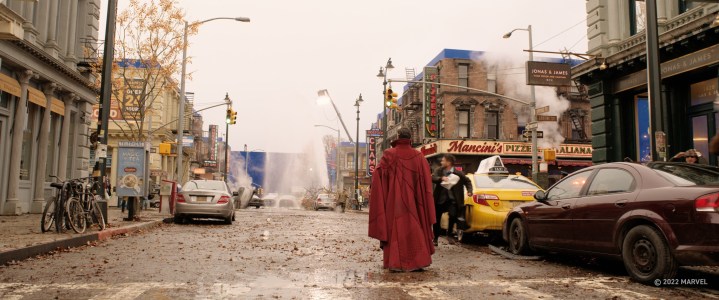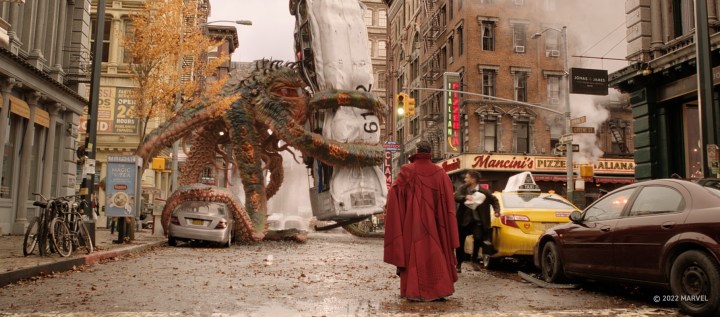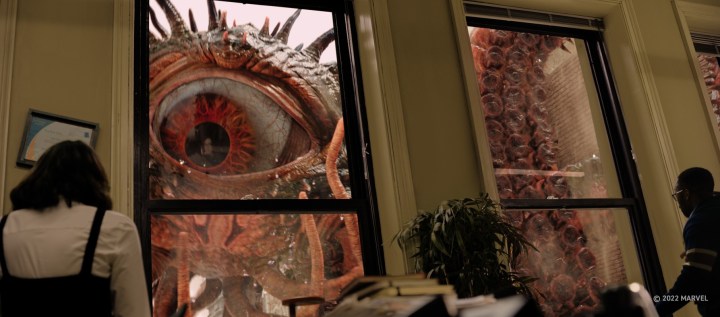Superhero sorcerer Stephen Strange sent Marvel Studios back to the top of the box office with Doctor Strange in the Multiverse of Madness, which had Benedict Cumberbatch’s titular hero explore the myriad dimensions of the Marvel Cinematic Universe.
Not only did the film introduce a long list of new characters, but it also brought filmmaker Sam Raimi back to Marvel after the Evil Dead director helmed the original, pre-MCU trilogy of Spider-Man films. To no one’s surprise, Raimi delivered one of the franchise’s darkest, most horror-fueled films to date, complete with terrifying zombies, gruesome deaths, and Gargantos — a massive, tentacled creature from a nightmarish dimension that tore apart Manhattan in the movie’s wild, opening scene.
In order to bring that scene and others to life, Marvel relied on a host of visual effects studios that each focused on bringing certain scenes and elements of Multiverse of Madness to the screen. Digital Trends spoke to Olivier Dumont and Michael Perdew of VFX studio Luma Pictures, who served as the studio’s VFX supervisor and Senior VFX Producer, respectively, about their work on the Gargantos battle, as well as the visual redesign they developed with Marvel for the film’s magic. They also offered up some thoughts on a few of those Doctor Strange rumors that circulated well before the film arrived on screens.

Digital Trends: Before we get into your process and such, approximately how many shots did Luma’s team work on in the film?
Michael Perdew: It was 266 shots, I believe.
Okay, so jumping right into that opening scene with Gargantos, how did that character’s big debut evolve over time?
Olivier Dumont: Well, we received the first concept from Marvel that basically gave us the general shape of the creature. That was out of context, though, so we went through a lot of iterations with it, making sure the scale would look good with the footage they shot and also the color. It was a lot of back and forth. The eye, in particular, went through a lot of different styles and changes to make sure we got the best out of it. The creature also has runes all over its body. They weren’t there at the beginning, but we added [the runes] to establish the relationship between the creature and Wanda — which is something people might catch and, later in the movie, realize why they were there. A big part of working on the creature was also the animation style. We tried to find a good compromise between something that looks animal, but at the same time, there’s some intelligence and emotion to it. So there was a lot of work to do on it.
Early on, everyone thought the creature in the trailer was going to be Shuma-Gorath, but it ended up being a different, tentacled Marvel creature, Gargantos. I’ve heard you’re a big Marvel fan, Michael, so what did you think of all that early speculation?
Perdew: Yeah, I don’t know what Marvel’s plans are for Shuma-Gorath, but in the comics, Gargantos is a variant of that character anyway. So we basically got to lift the design elements from Shuma-Gorath while working on Gargantos.
The interview just started, and we’re already down a deep rabbit hole of Marvel geekery…
Perdew: Right? As a kid, I grew up playing the Marvel vs. Capcom games and reading the comics and stuff, so it was really, really fun having [Gargantos] in the film. As soon as I knew he was in the movie — because there were a few iterations of the movie over time — we put our hands up. We were like, “Hey, we love creatures and Luma is a huge creature shop, so can we please, please, please do this one?” I basically begged to get it. And like Olivier said, you usually start with the literal translation of the comic book and then you explore all these options of how animalistic to get, how cartoony to make it look, and so on. Basically, how do you ground something that has such a bizarre design?
At the end of the day, though, I was really happy they went with probably the most literal translation of that character they possibly could, down to the orange eye that was controversial for minute, and then it wasn’t. I was so happy with it.


Dr. Strange and Wong both showcase some new magic in that scene that looks unlike anything we’ve seen before in the MCU films. What went into redesigning the look of their sorcery?
Dumont: Marvel wanted to show something different from what had been shown in the other movies with the mandala-type spells and that orange, sparky effect. They wanted to have something a little bit more concrete. The idea was to go back to the comic book and look at spells that were not seen before in the films.
For instance, the Fangs of Farallah is the spell with the big cat head that comes in. It’s depicted in the comic book as just a mouth with fangs, but we extrapolated on that to make it more understandable for the short time you see it. The same thing for Chains of… Wait, what was it again, Michael?
Perdew: “The Chains of Krakkan.”
Dumont: Right!
Perdew: One of the fun things we did was to incorporate the magic from the Doctor Strange comics of the ’60s. [In those comics] he’d say these very eccentric, over-the-top, dramatic phrases when casting certain spells. There’s a list of 20 or 30 of them out there…
BY THE HOARY HOSTS OF HOGGOTH!
Perdew: Yes! Exactly! We would reference that list and I’d point to one that sounded funny, and then Olivier would look up the comic book reference and we’d put our heads together and be like, “Is this one you can translate into something that would work in a film?” And then we’d work with our art department. It’s really fun as a concept artist or visual effects artist in general to see this comic book from the 1960s, especially in the Steve Ditko style with its hard-drawn lines and basic shapes, and being like, “How do I make this real?” That was a lot of fun.
What were some of the big challenges in creating that opening scene?
Dumont: Well, it was shot on a backlot in London. They built the first two stories of buildings, and then we had to extend them. That creates some challenges in terms of lighting because you need to be aware of where the sun is and the shaded areas and such. Fortunately, most of what was shot in London was overcast, so that made it easier, but we still had to compensate for that stuff and work out lighting for both the creature and all of the other objects.
The most challenging part to me, though, was making sure we followed continuity. Like, the creature is moving through a street, destroying stuff, so what’s happening in the next shot? You have to keep continuity there. Obviously, everything becomes almost full CG at the end because of the amount of destruction. So we had to identify and pay attention to the most important things that we needed to carry over from one shot to the other, in order to make the sequence look like it’s continuous.
So we had some full CG shots in there, but building these environments and categorizing all the elements that are being touched by the creature and being moved, all of that took a very long time to figure out.
Digital Trends: Well, you have eight tentacles of action to keep track of…
Dumont: It’s funny to me because I thought that animating a giant creature that has eight tentacles would be the hard part. But the animation team we have at Luma is amazing. For me, it was painless. All the people working with the creature were so good that animating those tentacles didn’t seem that hard, even though it’s a huge job.


Luma worked on both Doctor Strange films. How did Sam Raimi’s involvement change the experience this time around?
Perdew: I worked on both, and also worked with Sam Raimi before on Oz the Great and Powerful. So we already had a taste of his style. [With Multiverse of Madness], it’s all the normal, visual flairs of Sam Raimi: More gore, more point-of-view shots, and so on. We knew we were working on a big action scene, so we knew we’d also have a bunch of extras running around in panic and all kinds of chaos. It’s all very, very fun.
We also anticipated that with Sam, we have to show the goriest version of anything we work on first. There’s a scene where Gargantos dies (rest in peace) by being stabbed with the sharp end of a stick, so of course, we went in knowing we had to make it as violent as possible while still fitting into a PG-13 movie. So we weighed the balance of how realistic the blood could be versus what color it was, and all of the other tricks you go through. And with Sam Raimi, we knew that the edits and general snappiness of it would need to be very quick, very beat-to-beat. There’s no filler with him. There’s no lingering on a hero shot where it goes into slow motion, for example. That was actually kind of refreshing, to be honest. It’s nice doing an action scene where it’s like, action, action, action, action…
What was it like working on this film so far in advance — particularly on a scene like this — and then seeing all of the rumors and speculation that circulate in the lead-up to its release?
Perdew: Yeah, it’s so fun. I keep an eye on some of the comic book movie blogs, and I’ll have Reddit or ComicBookMovie.com open all day to see what they’re saying. I remember the early speculation that Shuma-Gorath was the main bad guy of the film, for example. I knew he wasn’t, but seeing the excitement building is so much fun. Of course, things start to leak and you obviously can’t comment on anything, even if it’s wildly off or if it’s 100% accurate.
Dumont: I liked the Tom Cruise one — that he would be Iron Man.
Perdew: Yeah, and it’s funny because we don’t necessarily see the entirety of the movie [while we’re working on it], either. So some of these rumors, for all we know, could be true. We don’t even know when we’re working on it!
Marvel’s Doctor Strange in the Multiverse of Madness will be available on June 22 on the Disney+ streaming service.
Editors' Recommendations
- The scariest MCU characters ranked
- Aliens, upgrades, and Dolly Parton: behind The Orville’s VFX
- Vines, gore, and rifts galore: Behind Stranger Things’ season 4 VFX
- How the Thanos VFX team brought The Quarry’s characters to life (and then killed them)
- Marvel’s Doctor Strange 2 will hit Disney+ later this month






